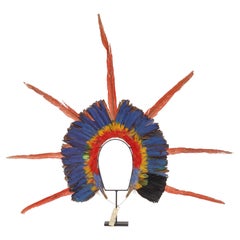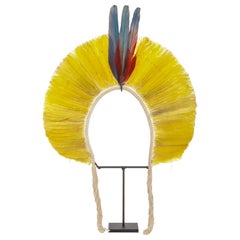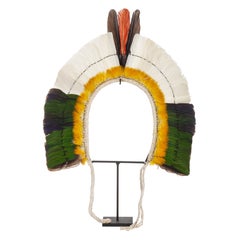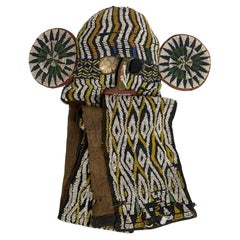Want more images or videos?
Request additional images or videos from the seller
1 of 2
Kayapo Small Feather Headdress, Akkakry-Re
$10,704.34List Price
About the Item
- Dimensions:Height: 29.93 in (76 cm)Width: 22.45 in (57 cm)Depth: 1.58 in (4 cm)
- Style:Native American (Of the Period)
- Materials and Techniques:
- Place of Origin:
- Period:
- Date of Manufacture:1930-1945
- Condition:Wear consistent with age and use.
- Seller Location:Amsterdam, NL
- Reference Number:1stDibs: LU5458220857072
About the Seller
5.0
Recognized Seller
These prestigious sellers are industry leaders and represent the highest echelon for item quality and design.
Established in 1985
1stDibs seller since 2020
23 sales on 1stDibs
Typical response time: 18 hours
Authenticity Guarantee
In the unlikely event there’s an issue with an item’s authenticity, contact us within 1 year for a full refund. DetailsMoney-Back Guarantee
If your item is not as described, is damaged in transit, or does not arrive, contact us within 7 days for a full refund. Details24-Hour Cancellation
You have a 24-hour grace period in which to reconsider your purchase, with no questions asked.Vetted Professional Sellers
Our world-class sellers must adhere to strict standards for service and quality, maintaining the integrity of our listings.Price-Match Guarantee
If you find that a seller listed the same item for a lower price elsewhere, we’ll match it.Trusted Global Delivery
Our best-in-class carrier network provides specialized shipping options worldwide, including custom delivery.You May Also Like
Carved Tribal Mask from Pacific Northwest Coast by David Frankel
Located in Atlanta, GA
A striking carved and painted mask in the tradition of the Native Indian tribes from Pacific Northwest Coast by David Frankel in 1994. The mask...
Category
1990s American Native American Masks
Materials
Natural Fiber, Wood
Yupik Yup'ik Native American Alaska Polychrome Wood Anthropomorphic Spirit Mask
Located in Studio City, CA
A beautiful, somewhat benevolent mask by the Yup'ik (Yupik) aboriginal, indigenous people of South-Western & South Central Alaska. The Yup'ik people, who are related to the Inuit peo...
Category
20th Century American Masks
Materials
Wood, Paint
$2,495
H 11 in W 13 in D 1.5 in
Yupik Yup'ik Native American Alaska Polychrome Wood Anthropomorphic Spirit Mask
Located in Studio City, CA
A beautiful, somewhat benevolent mask by the Yup'ik (Yupik) aboriginal, indigenous people of South-Western & South Central Alaska. The Yup'ik people, who are related to the Inuit peoples, have a long history of ceremonial mask making. Yup'ik masks were originally and specifically designed by Shamans and made to be worn by these spiritual leaders in Winter tribal dances and sacred ceremonies. Traditionally, the masks were destroyed or discarded after use in these ceremonies. Very few of these masks survived. After Christian contact in the late 19th century, masked dancing was suppressed and the tradition all but died out. As more outsiders settled in Alaska at the turn of the century, masks were made by the Yup'ik people to sell or trade for necessary goods. It is likely that this mask was created some years later for this purpose.
In the 20th century, Yup'ik mask had a profound influence on many renowned surrealist artists including, Max Ernst, Joan Miro, Leonora Carrington, Victor Brauner, and most notably Andre Breton who was an avid collector of Yup'ik masks.
This fantastic anthropomorphic mask is carved of lighter wood and hand painted/ decorated with pigment. The mask seems to represent some sort of smiling, benevolent spirit or character.
The mask is from a French collection. We were told that this mask, as well as others in the collection we have listed, was acquired originally in the 1950s-1960s in Alaska and the Yukon territory in Canada but as we have no way to verify or authenticate this. Please note we are listing the masks as decorative and not as actual tribal artifacts...
Category
20th Century American Masks
Materials
Wood, Paint
$2,495
H 11.5 in W 13.5 in D 1.5 in
Yupik Yup'ik Native American Alaska Carved Polychrome Wood Anthropomorphic Mask
Located in Studio City, CA
A fantastic and somewhat playful mask by the Yup'ik (Yupik) aboriginal, indigenous people of South-Western & South Central Alaska. The Yup'ik people, who are related to the Inuit peoples, have a long history of ceremonial mask making. Yup'ik masks were originally and specifically designed by Shamans and made to be worn by these spiritual leaders in Winter tribal dances and sacred ceremonies. Traditionally, the masks were destroyed or discarded after use in these ceremonies. Very few of these masks survived. After Christian contact in the late 19th century, masked dancing was suppressed and the tradition all but died out. As more outsiders settled in Alaska at the turn of the century, masks were made by the Yup'ik people to sell or trade for necessary goods. It is likely that this mask was created some years later for this purpose.
In the 20th century, Yup'ik mask had a profound influence on many renowned surrealist artists including, Max Ernst, Joan Miro, Leonora Carrington, Victor Brauner, and most notably Andre Breton who was an avid collector of Yup'ik masks.
This fantastic anthropomorphic mask is carved of lighter wood, hand painted and decorated with pigment, and held together with natural fiber. The mask seems to represent some sort of smiling, benevolent spirit or character with its four eyes, bird beak, and cat-like ears.
The mask is from a French collection. We were told that this mask, as well as others in the collection we have listed, was acquired originally in the 1950s-1960s in Alaska and the Yukon territory in Canada but as we have no way to verify or authenticate this. Please note we are listing the masks as decorative and not as actual tribal artifacts...
Category
20th Century American Masks
Materials
Natural Fiber, Wood, Paint
$2,495
H 16 in W 13 in D 4.5 in
Yupik Yup'ik Native American Alaska Carved Polychrome Wood Anthropomorphic Mask
Located in Studio City, CA
A fantastic and somewhat grotesquely strange mask by the Yup'ik (Yupik) aboriginal, indigenous people of South-Western & South Central Alaska. The Yup'ik people, who are related to t...
Category
20th Century American Masks
Materials
Natural Fiber, Wood, Paint
$2,495
H 17.5 in W 14 in D 2.5 in
Yupik Yup'ik Native American Alaska Polychrome Wood Anthropomorphic Spirit Mask
Located in Studio City, CA
A fantastic, somewhat sinister appearing mask by the Yup'ik (Yupik) aboriginal, indigenous people of South-Western & South Central Alaska. The Yup'ik people, who are related to the I...
Category
20th Century American Masks
Materials
Wood, Paint
$2,495
H 12 in W 9.75 in D 2 in
Split Horn Headdress
Located in Coeur d'Alene, ID
Heavily adorned split horn headdress with ermine drops, silk ribbons, hawk bells, stroud covered horns, brass trade beads and brass buttons on red strou...
Category
Antique 19th Century American Native American Native American Objects
Materials
Fur
Signed Monumental Folk Art Rouge Taxidermy Headdress Mask
Located in Forney, TX
A magnificent American folk art headdress mask by P.J. Stover, signed, titled "Visions", circa 2008. Remarkably executed, the eclectic, sculptural mixed media wall hanging display is...
Category
Early 2000s American Native American Masks
Materials
Antler, Fur, Leather, Beads, Feathers
Contemporary Kayapo-Style Headdress With Moulting Feathers
Located in Paris, FR
Headdress in the style of Indian Tribe Kayapo under frame, made of moulting feathers from Blue Macaw, Blue-fronted Amazon, Rosablin, Triton and Alba cacaotès, Alexander parakeet, Demoiselle and Crowned crane, Chinese red rooster and Blue peacock; all sourced within France.
With Lapis lazulli...
Category
21st Century and Contemporary French Tribal Tribal Art
Materials
Glass, Wood, Feathers
19th Century Blackfeet Split Horn Headdress
By Native American Art
Located in Coeur d'Alene, ID
Blackfeet or crow split horn headdress collected by Ron Hall at Browning, Montana from grandson of Edward Axe (Blackfeet) who acquired from Jack B...
Category
Antique Late 19th Century American Native American Native American Objects
Materials
Hide, Beads, Feathers
More From This Seller
View AllA Kayapo Amazon Indigenous feather headdress
Located in Amsterdam, NL
Brazil, Pará, circa 1950s-1960s
H. 97 x W. 106 cm
Provenance:
Collection Rinck Hollnberger, Munich
(purchased in the 1980s)
Category
20th Century Brazilian Tribal Art
Materials
String, Feathers
An Amazon Indigenous Kayapo feather headdress
Located in Amsterdam, NL
Brazil, Pará or Mato Grosso, circa 1950’s-1960s
H. 55 x W. 38 cm (incl. stand)
Provenance:
Collection Rinck Hollnberger, Munich
(purchased in the 1980s)
Category
20th Century Brazilian Tribal Art
Materials
String, Feathers
An Amazon Indigenous Kayapo feather headdress
Located in Amsterdam, NL
Brazil, Pará or Mato Grosso, circa 1950’s-1960s
H. 50.8 x W. 33.5 cm (incl. stand)
Provenance:
Collection Rinck Hollnberger, Munich
(purchased in the 1980s)
Category
20th Century Brazilian Tribal Art
Materials
String, Feathers
A Kuosi society elephant mask
Located in Amsterdam, NL
Bamileke, Cameroon, early 20th century
Among the Bamileke people, only members of the Kuosi society (the elephant society) are permitted to perform elephant masquerades, symbolizing...
Category
Early 20th Century Cameroonian Masks
Materials
Cotton, Beads
An Asmat headdress decorated with cassowary feathers
Located in Amsterdam, NL
Asmat, Papua Province, Indonesia, Late 19th century
Provenance:
- Collection Rinck Hollnberger, Munich (purchased in the 1980s or 1990s)
Category
Antique Late 19th Century Indonesian Tribal Art
Materials
Natural Fiber, Feathers
Large Brazilian or Guyana Amazon Indigenous Macana War Club, 18th or Earlier
Located in Amsterdam, NL
A splendid and rare Amazon indigenous wamara wood Macana war-club
Southern-Guyana or Northern Brazil, Wapitxana group of the Aruak peoples, 18th century, possibly earlier
Measure: H. 43 cm
The deep patina of the club present, and the residue on the part where it was held, attest to its great age.
This unusually large Macana is decorated with several incised whitened anthropomorphic and human figures, a decoration only found on one other documented club in the British Museum, which is illustrated in: Hjalmar Stolpe, Amazon Indian...
Category
Antique Early 18th Century Brazilian Native American Objects
Materials
Hardwood
Recently Viewed
View AllMore Ways To Browse
Native American Feather
Brazilian Antique Art
Native American Headdress
Brazilian Feather
Kayapo Headdress
Brazil Feather Headdress
Brazil Headdress
Brazilian Masks
Antique Wood Mask
African Wood Mask
Mask Collection
Masks Of Africa
Wooden Carved Masks
Ceremonial Mask
Mask Mexico
Indonesia Mask
Venetian Mask
Mask Wood Indonesian



